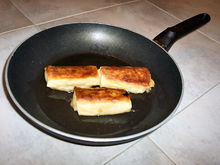- Non-stick pan
-
Non-stick pans are cooking pans made from or coated with materials designed to prevent food from sticking to their surface during the cooking process. Most non-stick pans are made using Teflon (PTFE) coating although newer materials are also used. Health concerns have been raised regarding use of PTFE as a cooking pan coating.
Contents
Development
The first non-stick pans were made using a coating of Teflon (polytetraflouroethylene or PTFE). PTFE was invented serendipitously by Dr. Roy Plunkett[1] in 1938, while working for a joint venture of the DuPont company. The substance was found to have several unique properties, including very good corrosion resistance and the lowest coefficient of friction of any substance yet manufactured. PTFE was used first to make seals resistant to the uranium hexafluoride gas used in the Manhattan Project during World War II and was regarded as a military secret. Dupont registered the Teflon trademark in 1944 and soon began planning for post-war commercial use of the new product.[2]
By 1951, Dupont had developed applications for Teflon in commercial bread and cookie-making, however the company avoided the market for consumer cookware due to potential problems associated with release of toxic gases if stovetop pans were overheated in inadequately ventilated spaces. Marc Grégoire, a French engineer, had begun coating his fishing gear with Teflon to prevent tangles. His wife Colette suggested using the same method to coat her cooking pans. The idea was successful and a French patent was granted for the process in 1954. The Tefal company was formed in 1956 to manufacture non-stick pans.[2]
Modern non-stick pans do not necessarily use Teflon. Other non-stick coatings for pans have since been invented. For example, a mixture of titanium and ceramic can be sandblasted onto the pan surface, and then fired to 2,000 °C (3,630 °F).[3]
Uses and limitations
Non-stick pans are useful in cooking since they require much less cooking oil to allow the food to be moved about the cooking pan. The cleanup process is also made much easier for foods which leave a residue on the pan.
PTFE-coated frying pans usually require the use of a non-metallic (usually plastic) spatula to avoid scratching of the coated surface.
Tony Polombo observes that non-stick pans are not a universal panacea. He notes that, in particular, ordinary stainless steel pans are better for producing pan gravy, because the fond (the caramelized drippings that stick to the pan when meat is cooked) sticks to them, and can be turned into pan gravy by deglazing them — dissolving them in liquid. Non-stick pans, according to Polombo, produce inferior pan gravies.[4]
Health concerns
Concerns have been raised over the possible negative effects of using PTFE-coated cooking pans. When pans are overheated beyond approximately 349 °C (660 °F) the PTFE coating begins to dissociate, releasing byproducts which can cause polymer fume fever in humans and can be lethal to birds.[2][5][6] Compounds in non-stick cookware may be associated with elevated cholesterol levels in children and teens.[7]
References
- ^ https://www.chemheritage.org/classroom/chemach/plastics/plunkett.html
- ^ a b c Anne Cooper Funderburg. "Making Teflon Stick". Invention and Technology Magazine. Summer 2000 16 (1). http://www.americanheritage.com/articles/magazine/it/2000/1/2000_1_10.shtml. Retrieved 2009-05-06.
- ^ Pennie Stoyles and Peter Pentland (2007). "Non-stick pan". A to Z of Inventions and Inventors: M to P. Black Rabbit Books. pp. 17. ISBN 1583407898.
- ^ Tony Polombo (2006). "Pots and Pans". Cooking. iUniverse. pp. 20. ISBN 0595378668.
- ^ "Safety of Teflon Non-Stick Coatings for Cookware". DuPont. Archived from the original on 2008-01-17. http://web.archive.org/web/20080117234907/http://www.teflon.com/Teflon/teflonissafe/keyquestions.html#q2. Retrieved 2009-05-06.
- ^ Jane Houlihan et al.. "EWG finds heated Teflon pans can turn toxic faster than DuPont claims". EWG. http://www.ewg.org/reports/toxicteflon. Retrieved 2009-05-06.
- ^ Health Concerns
http://www.kitchenwaresuperstore.com.au/blog/how-long-should-non-stick-cookware-last/
Categories:
Wikimedia Foundation. 2010.


